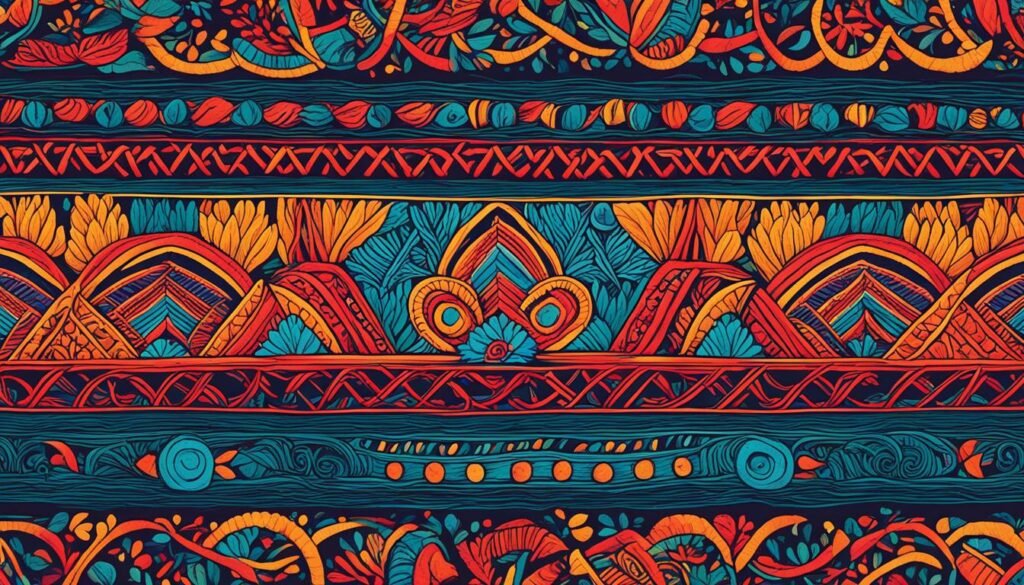Dive into the captivating realm of the Banu, a sentient, bipedal species. They are known for their vibrant mercantile society and peaceful trade relations with other spacefaring civilizations. The Banu Protectorate is a republic of planet-states that has a strong tie with the UEE. This relationship is based on economic trade and cultural exchange. The Banu were the first alien species that Humans met. This meeting led to a joint effort in information and technology sharing. Their goal was to explore the universe together.
The Banu excel at being the traders and culture-hounds of the universe. Their planets are full of vibrant colors and intriguing tales. These stories often start in the murky back alleys of Banu cities. What sets them apart is that they freely trade with all known spacefaring civilizations. This includes their dealings with the Vanduul, a powerful group. However, the exact nature of these trading relationships can vary widely.
Key Takeaways
- The Banu are a sentient, bipedal species known for their vibrant mercantile society.
- The Banu Protectorate, a republic of planet-states, has a strong relationship with the UEE built on economic trade and cultural exchange.
- The Banu were the first sentient species encountered by Humanity, leading to a mutually beneficial exchange of information and technology.
- Banu planets are diverse, colorful, and often filled with tales of intrigue starting in the back alleys of their cities.
- The Banu openly trade with all known spacefaring civilizations, including the Vanduul, though the nature of these relationships varies.
Exploring the BANI Paradigm
Our world today faces many challenges that are not easy to wrap our heads around. The BANI framework helps us understand these. It stands for Brittle, Anxious, Nonlinear, and Incomprehensible. This tool lets us look closely at the complexities, uncertainties, and fast changes of our time.
Understanding BANI
The BANI framework is for understanding our complex, volatile, and uncertain world. It breaks down into VUCA (Volatility, Uncertainty, Complexity, Ambiguity) and TUNA (Turbulent, Uncertain, Novel, Ambiguous). This approach helps us see the challenges clearly and find ways to deal with them well.
The Four Elements of BANI
The BANI framework includes four key points that show how our world works today:
- Brittle: Modern systems can easily fail due to a focus on profit and being too efficient, ignoring their weaknesses.
- Anxious: Uncertainty makes everyone anxious. This can lead to playing it safe, which doesn’t help with trying new things or adapting.
- Nonlinear: Our interconnected world doesn’t follow simple cause-and-effect patterns. Predicting the outcomes of our actions is hard.
- Incomprehensible: All these challenges together make our world very hard to understand. Sometimes, we feel lost and powerless.
Using the BANI framework can help both people and groups understand our current world better. It equips them to face the many challenges of today, including those we can’t predict.
Brittle: Navigating Fragile Systems
In today’s world, our surroundings are not just changing fast, they’re becoming less flexible too. This makes them weak to sudden, big failures. These systems might look steady, but they can easily break and fall apart.
Overemphasis on Profit and Efficiency
Hunting for profit and maxing out efficiency can weaken companies. They might forget about keeping their employees happy and well. This can make them less able to handle tough times in the future.
Ignoring Weaknesses and Vulnerabilities
If we don’t fix or notice the weak spots in our systems, they get more fragile. Not preparing for possible failures or not making strong plans can make us all more vulnerable. This is especially true nowadays when big surprises happen often.
Global Interconnectedness and Cascading Effects
Everything in the world is now super connected. So, if one part fails, it can set off a chain reaction. This can cause a problem to spread quickly everywhere. To fight this, we need systems that are ready for these surprises.
To deal with the problems of fragile systems, we need to be ready to bounce back. This means noticing our weak spots, adding extra protection, and looking at the big picture when solving problems. Doing this will help us face any challenge that comes our way.
Anxious: Embracing Uncertainty
The BANI framework shows that anxiety and uncertainty are closely linked. This happens when people fear that something big could fall apart at any moment. Anxiety helps people and groups protect their safety in a world full of surprises.
Anxiety and Its Connection to Uncertainty
Our world is becoming more anxious, leading to a lack of action. People and groups are avoiding risks more than ever. This keeps individuals from trying new things and stops businesses from making daring choices, affecting how decisions are made.
Consequences of an Anxious World
The media plays a key role in making us all feel anxious, using stories that feed our fears and uncertainties. To move forward, we need to break free from this fear and be more optimistic and active. This is crucial for pushing new technology, encouraging fresh ideas, and changing business strategies to stay ahead in a rapidly evolving environment.
Non-Linear: Challenging Cause-and-Effect
The world today is getting more non-linearly complex. This means that the usual way we see cause and effect doesn’t always apply. The link between our actions and their outcomes can be hard to see. This challenges how we solve problems and make decisions, making us reassess what we think we know about the world.
Non-Linear Complexity
Our systems are really complex, having many parts that work together. This non-linear complexity means the effects of actions can be hidden. Also, the steps we take might not always show clear results that we expect.
Unpredictability in Outcomes
Dealing with non-linear systems means facing unpredictability. Even small changes at the start can lead to very different results. This makes it hard to guess what will happen from what we do. So, we need to look beyond simple cause-and-effect logic.
Global Warming as an Illustrative Example
Think of global warming as a big example of non-linearity. The time it takes for causes and effects to show is quite long. This makes understanding the full picture tricky. Many things, like cutting down forests and ocean currents, change the climate. But the effects are not simple and straight. To tackle global warming, we need to understand these complex connections for real solutions.

Incomprehensible: Beyond Ambiguity
Incomprehensibility is the peak of complication in our non-linear world. It goes beyond simple ambiguity. In a non-linear world, even unimportant elements greatly affect the system. This makes understanding the workings very hard. So, we feel things are impossible to grasp.
Our world’s non-linear aspect hides simple cause-and-effect patterns. This makes outcomes unpredictable and often surprising. Events can snowball from a single moment. It’s tough to forecast how our choices will ripple out. This creates a troubling ambiguity that shakes our confidence and disrupts our planning.
But, facing this challenge offers a chance to grow and adapt. Accepting the incomprehensibility of a non-linear world can make us more flexible. We become ready for the unexpected twists of life. Changing our view lets us find beauty and opportunity in the ambiguity around us. This lights the path for new solutions and big changes.
Moving Beyond VUCA and TUNA
The VUCA and TUNA frameworks tackle our wild world’s challenges. But, they focus mainly on what’s outside. They miss the part about how we feel and interact in this fast-paced world. The BANI framework includes our feelings and actions, offering a more complete view.
The Limitations of VUCA and TUNA
VUCA and TUNA are good for looking at what’s happening in the world. But, they skip over how we think and feel. The liminal parts of our experience get left out. This means they’re not the full story for figuring out how people and groups deal with big changes.
Embracing the ALIVE Mindset
The ALIVE mindset adds a missing piece. It looks at the lively, ever-changing nature of our world. This mindset helps us be ready and open to new chances. By thinking this way, we get better at seeing and using the exciting parts of life.

bani world: A Vibrant Mercantile Society
The Banu are known for their lively trade-eager society. They keep peace while trading with various known civilizations. Their republic, the Banu Protectorate, has built a strong bond with the UEE.
Origins and Homeworld
The Banu’s beginnings are a mystery, and they rarely document history. Experts in the UEE think their home might be Bacchus II. However, the Banu have neither confirmed nor denied this thought.
Trade and Cultural Exchange
Trade and cultural sharing are strong suits for the Banu. This has helped both the Banu Protectorate and the UEE grow in the galaxy. It’s a win-win for everyone involved.
Banu Inhabited Systems
In 2439, after the Peace & Trade Accord, the Banu shared the locations of their systems. This boosted trade, exploration, and cultural mixing. It benefited the Banu and the UEE equally.
Social Structures and Traditions
The Banu are known for their rich social structures and lively traditions. The core of their society is the Souli, much like human guilds. These groups help Banu with work, life, and teaching skills to their youth from a young age.
Role of Souli in Banu Society
The Souli are essential in Banu life, shaping both culture and economy. Each Souli focuses on a craft or trade. This helps Banu learn, improve their abilities, and make a living.
The network of Souli ensures the Banu have a strong, varied economy. Skilled workers and traders add to their rich commercial culture.
Significance of Trade
Trade is the key part of Banu society, seen across all their Protectorate systems. Even with different cultures and traditions, a shared love for business ties the Banu planets together.
Banu markets are lively, attracting all kinds of people. There, you can buy almost anything, if you have the money.
